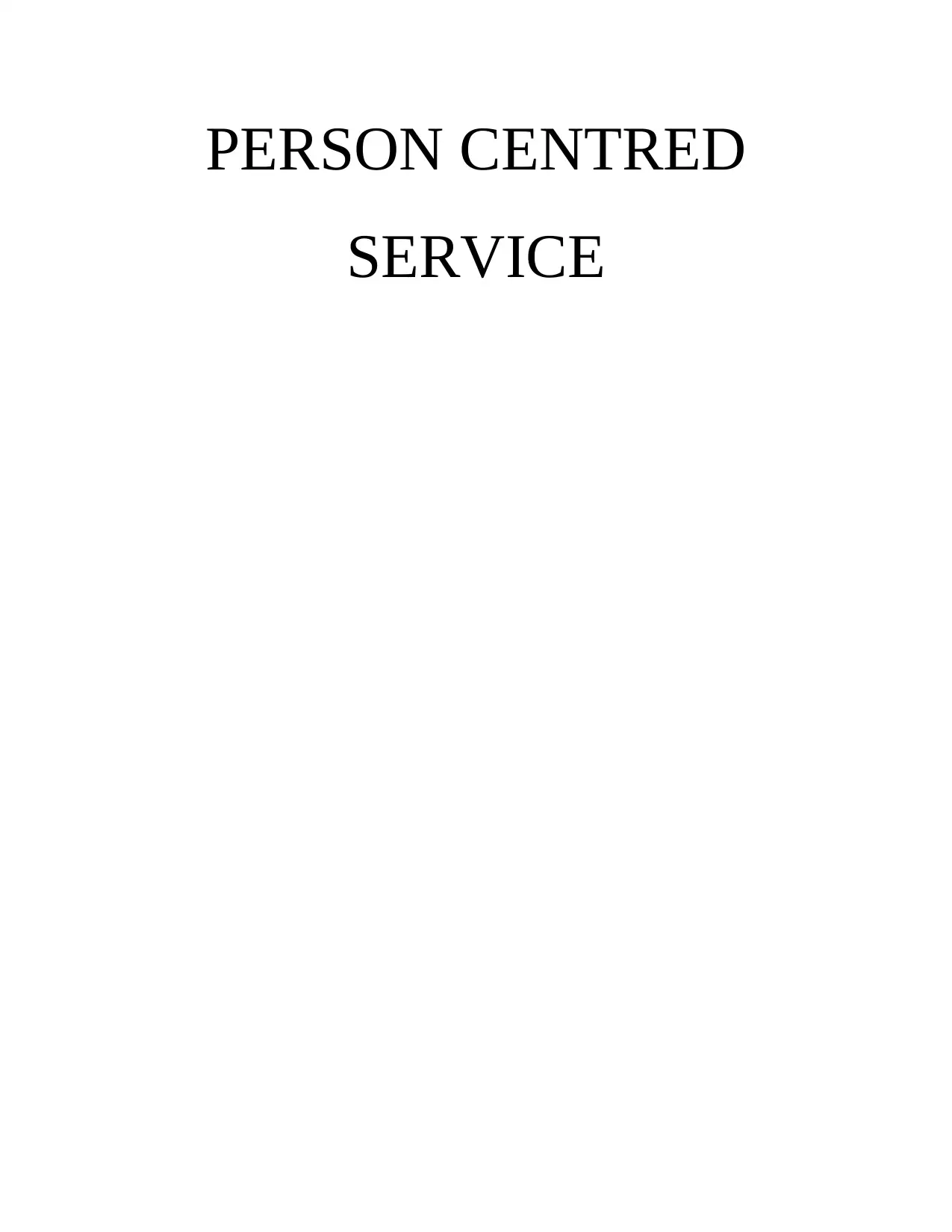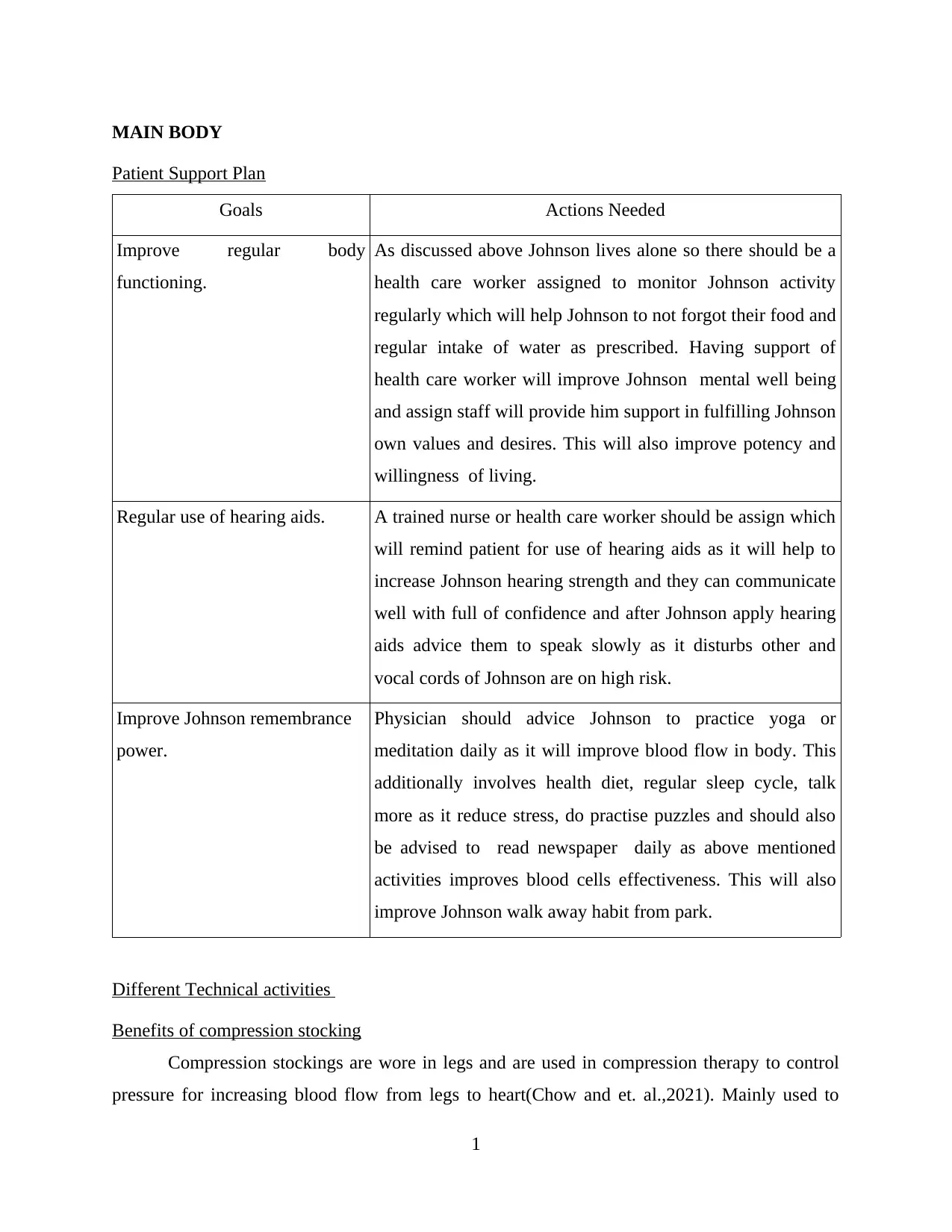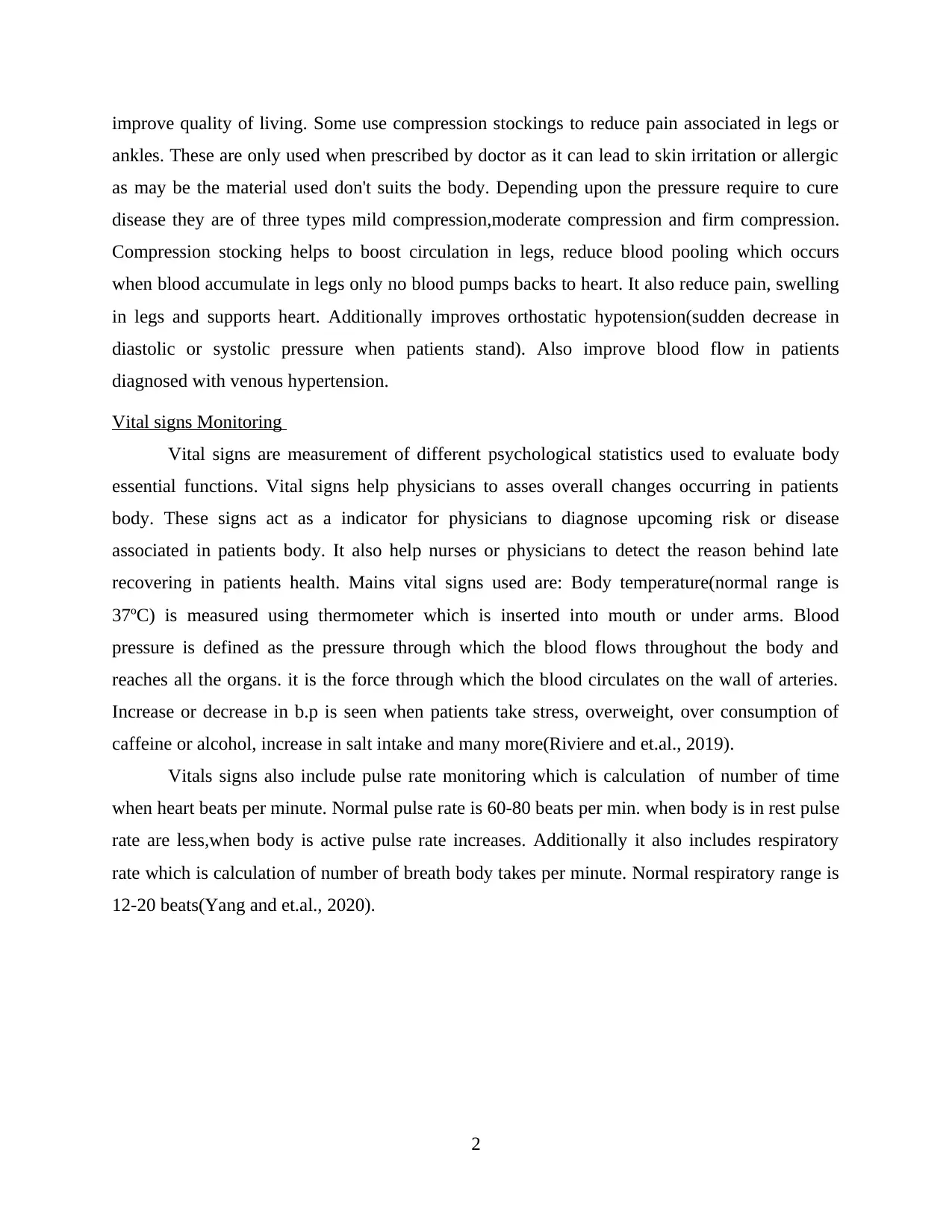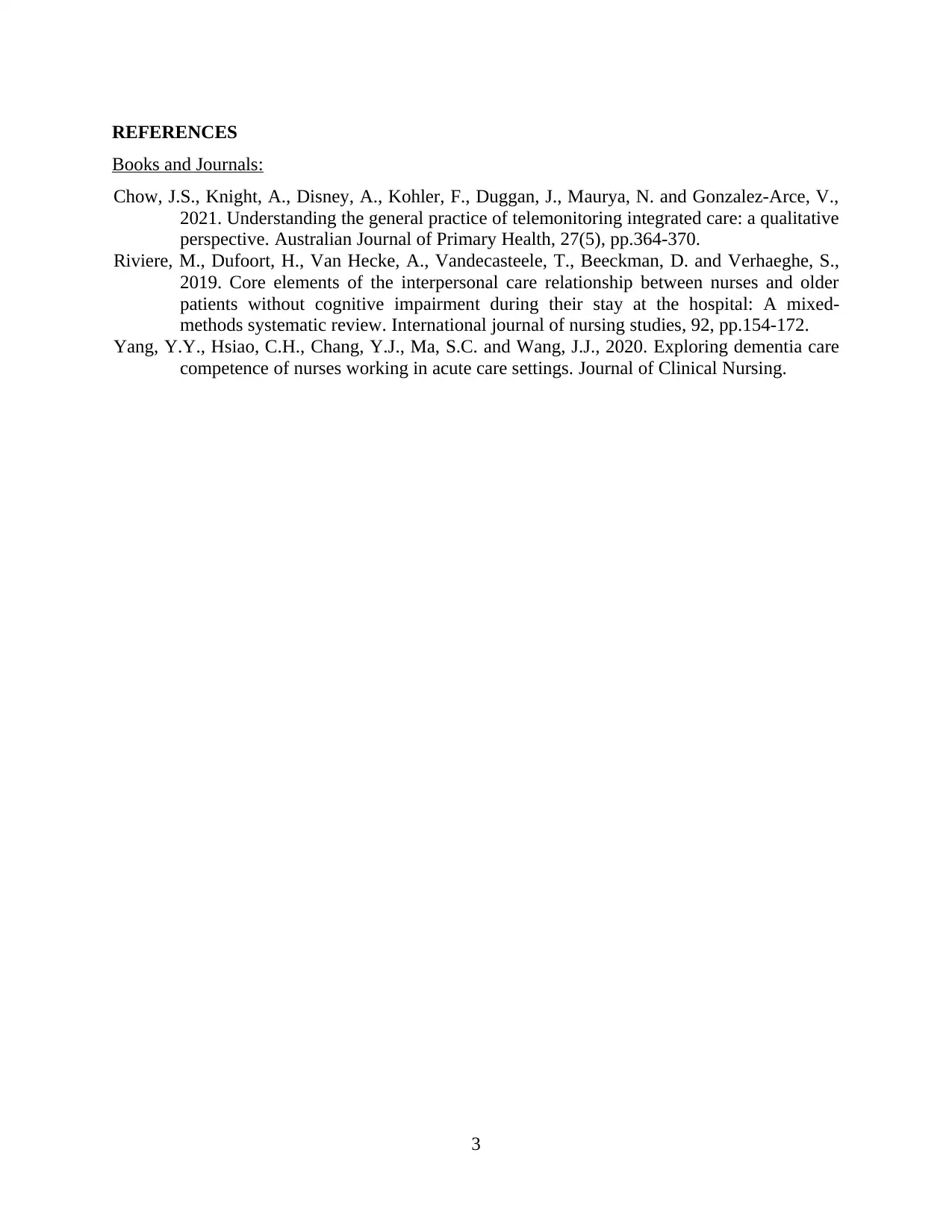Patient-Centred Service Report: Support Plan, Vital Signs Analysis
VerifiedAdded on 2023/06/09
|4
|820
|367
Report
AI Summary
This report presents a person-centred service approach to patient care, focusing on a support plan for an individual named Johnson. The plan includes goals to improve his well-being, actions such as regular healthcare worker visits, and the use of hearing aids to enhance communication. The report also delves into the benefits of compression stockings, detailing their use in improving blood flow and quality of life, and discusses vital signs monitoring, including body temperature, blood pressure, pulse rate, and respiratory rate, as essential indicators of a patient's health. References to relevant journal articles are provided to support the information presented.

PERSON CENTRED
SERVICE
SERVICE
Paraphrase This Document
Need a fresh take? Get an instant paraphrase of this document with our AI Paraphraser

MAIN BODY
Patient Support Plan
Goals Actions Needed
Improve regular body
functioning.
As discussed above Johnson lives alone so there should be a
health care worker assigned to monitor Johnson activity
regularly which will help Johnson to not forgot their food and
regular intake of water as prescribed. Having support of
health care worker will improve Johnson mental well being
and assign staff will provide him support in fulfilling Johnson
own values and desires. This will also improve potency and
willingness of living.
Regular use of hearing aids. A trained nurse or health care worker should be assign which
will remind patient for use of hearing aids as it will help to
increase Johnson hearing strength and they can communicate
well with full of confidence and after Johnson apply hearing
aids advice them to speak slowly as it disturbs other and
vocal cords of Johnson are on high risk.
Improve Johnson remembrance
power.
Physician should advice Johnson to practice yoga or
meditation daily as it will improve blood flow in body. This
additionally involves health diet, regular sleep cycle, talk
more as it reduce stress, do practise puzzles and should also
be advised to read newspaper daily as above mentioned
activities improves blood cells effectiveness. This will also
improve Johnson walk away habit from park.
Different Technical activities
Benefits of compression stocking
Compression stockings are wore in legs and are used in compression therapy to control
pressure for increasing blood flow from legs to heart(Chow and et. al.,2021). Mainly used to
1
Patient Support Plan
Goals Actions Needed
Improve regular body
functioning.
As discussed above Johnson lives alone so there should be a
health care worker assigned to monitor Johnson activity
regularly which will help Johnson to not forgot their food and
regular intake of water as prescribed. Having support of
health care worker will improve Johnson mental well being
and assign staff will provide him support in fulfilling Johnson
own values and desires. This will also improve potency and
willingness of living.
Regular use of hearing aids. A trained nurse or health care worker should be assign which
will remind patient for use of hearing aids as it will help to
increase Johnson hearing strength and they can communicate
well with full of confidence and after Johnson apply hearing
aids advice them to speak slowly as it disturbs other and
vocal cords of Johnson are on high risk.
Improve Johnson remembrance
power.
Physician should advice Johnson to practice yoga or
meditation daily as it will improve blood flow in body. This
additionally involves health diet, regular sleep cycle, talk
more as it reduce stress, do practise puzzles and should also
be advised to read newspaper daily as above mentioned
activities improves blood cells effectiveness. This will also
improve Johnson walk away habit from park.
Different Technical activities
Benefits of compression stocking
Compression stockings are wore in legs and are used in compression therapy to control
pressure for increasing blood flow from legs to heart(Chow and et. al.,2021). Mainly used to
1

improve quality of living. Some use compression stockings to reduce pain associated in legs or
ankles. These are only used when prescribed by doctor as it can lead to skin irritation or allergic
as may be the material used don't suits the body. Depending upon the pressure require to cure
disease they are of three types mild compression,moderate compression and firm compression.
Compression stocking helps to boost circulation in legs, reduce blood pooling which occurs
when blood accumulate in legs only no blood pumps backs to heart. It also reduce pain, swelling
in legs and supports heart. Additionally improves orthostatic hypotension(sudden decrease in
diastolic or systolic pressure when patients stand). Also improve blood flow in patients
diagnosed with venous hypertension.
Vital signs Monitoring
Vital signs are measurement of different psychological statistics used to evaluate body
essential functions. Vital signs help physicians to asses overall changes occurring in patients
body. These signs act as a indicator for physicians to diagnose upcoming risk or disease
associated in patients body. It also help nurses or physicians to detect the reason behind late
recovering in patients health. Mains vital signs used are: Body temperature(normal range is
37ºC) is measured using thermometer which is inserted into mouth or under arms. Blood
pressure is defined as the pressure through which the blood flows throughout the body and
reaches all the organs. it is the force through which the blood circulates on the wall of arteries.
Increase or decrease in b.p is seen when patients take stress, overweight, over consumption of
caffeine or alcohol, increase in salt intake and many more(Riviere and et.al., 2019).
Vitals signs also include pulse rate monitoring which is calculation of number of time
when heart beats per minute. Normal pulse rate is 60-80 beats per min. when body is in rest pulse
rate are less,when body is active pulse rate increases. Additionally it also includes respiratory
rate which is calculation of number of breath body takes per minute. Normal respiratory range is
12-20 beats(Yang and et.al., 2020).
2
ankles. These are only used when prescribed by doctor as it can lead to skin irritation or allergic
as may be the material used don't suits the body. Depending upon the pressure require to cure
disease they are of three types mild compression,moderate compression and firm compression.
Compression stocking helps to boost circulation in legs, reduce blood pooling which occurs
when blood accumulate in legs only no blood pumps backs to heart. It also reduce pain, swelling
in legs and supports heart. Additionally improves orthostatic hypotension(sudden decrease in
diastolic or systolic pressure when patients stand). Also improve blood flow in patients
diagnosed with venous hypertension.
Vital signs Monitoring
Vital signs are measurement of different psychological statistics used to evaluate body
essential functions. Vital signs help physicians to asses overall changes occurring in patients
body. These signs act as a indicator for physicians to diagnose upcoming risk or disease
associated in patients body. It also help nurses or physicians to detect the reason behind late
recovering in patients health. Mains vital signs used are: Body temperature(normal range is
37ºC) is measured using thermometer which is inserted into mouth or under arms. Blood
pressure is defined as the pressure through which the blood flows throughout the body and
reaches all the organs. it is the force through which the blood circulates on the wall of arteries.
Increase or decrease in b.p is seen when patients take stress, overweight, over consumption of
caffeine or alcohol, increase in salt intake and many more(Riviere and et.al., 2019).
Vitals signs also include pulse rate monitoring which is calculation of number of time
when heart beats per minute. Normal pulse rate is 60-80 beats per min. when body is in rest pulse
rate are less,when body is active pulse rate increases. Additionally it also includes respiratory
rate which is calculation of number of breath body takes per minute. Normal respiratory range is
12-20 beats(Yang and et.al., 2020).
2
⊘ This is a preview!⊘
Do you want full access?
Subscribe today to unlock all pages.

Trusted by 1+ million students worldwide

REFERENCES
Books and Journals:
Chow, J.S., Knight, A., Disney, A., Kohler, F., Duggan, J., Maurya, N. and Gonzalez-Arce, V.,
2021. Understanding the general practice of telemonitoring integrated care: a qualitative
perspective. Australian Journal of Primary Health, 27(5), pp.364-370.
Riviere, M., Dufoort, H., Van Hecke, A., Vandecasteele, T., Beeckman, D. and Verhaeghe, S.,
2019. Core elements of the interpersonal care relationship between nurses and older
patients without cognitive impairment during their stay at the hospital: A mixed-
methods systematic review. International journal of nursing studies, 92, pp.154-172.
Yang, Y.Y., Hsiao, C.H., Chang, Y.J., Ma, S.C. and Wang, J.J., 2020. Exploring dementia care
competence of nurses working in acute care settings. Journal of Clinical Nursing.
3
Books and Journals:
Chow, J.S., Knight, A., Disney, A., Kohler, F., Duggan, J., Maurya, N. and Gonzalez-Arce, V.,
2021. Understanding the general practice of telemonitoring integrated care: a qualitative
perspective. Australian Journal of Primary Health, 27(5), pp.364-370.
Riviere, M., Dufoort, H., Van Hecke, A., Vandecasteele, T., Beeckman, D. and Verhaeghe, S.,
2019. Core elements of the interpersonal care relationship between nurses and older
patients without cognitive impairment during their stay at the hospital: A mixed-
methods systematic review. International journal of nursing studies, 92, pp.154-172.
Yang, Y.Y., Hsiao, C.H., Chang, Y.J., Ma, S.C. and Wang, J.J., 2020. Exploring dementia care
competence of nurses working in acute care settings. Journal of Clinical Nursing.
3
1 out of 4
Related Documents
Your All-in-One AI-Powered Toolkit for Academic Success.
+13062052269
info@desklib.com
Available 24*7 on WhatsApp / Email
![[object Object]](/_next/static/media/star-bottom.7253800d.svg)
Unlock your academic potential
Copyright © 2020–2025 A2Z Services. All Rights Reserved. Developed and managed by ZUCOL.





